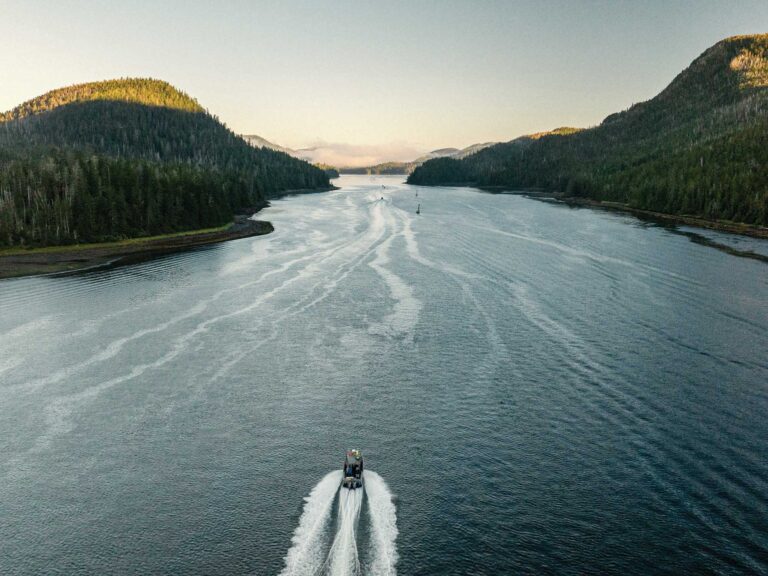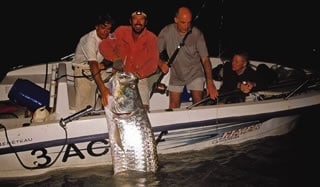
Few anglers in the world have heard of Guinea-Bissau. Ask even a well-traveled American to point it out on a map and chances are you’ll draw a blank stare. Tell the same angler that the average tarpon in this relatively unknown nation weighs over 200 pounds and his expression will likely change to one of skepticism. Before my visit to Guinea-Bissau last April, I too was a skeptic. However, after having fished the area firsthand I can tell you that my image of what a giant tarpon is has been irrevocably altered.
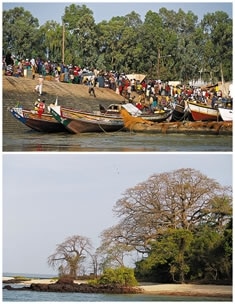
(top) The waterfront at this exotic locale bustles with activity. (bottom) Many parts of the Guinea-Bissau coast remain pristine.|
Guinea-Bissau’s failure to appear on the radar screen of the American angling public is not without reason. This tiny nation of 1.3 million, located south of Senegal and north of Guinea and Sierra Leon, on the northern coast of West Africa, has had a long, hard path over the last 35 years. Originally a repressed Portuguese colony where residents were forced to cultivate groundnuts and cashews, the nation’s initial bid at self-governance began in 1961 with a Soviet-and-Cuban-backed revolution that dragged on for 13 years. After gaining independence in 1973, its attempt at socialism proved equally dismal, and several forms of somewhat more democratic government followed. Sadly, these times were rife with power struggles, revolutions and coups until the country finally had its first transparent election in 2000. Since then, Guinea-Bissau has been slowly and peacefully rebuilding, yet it remains one of the poorest nations in the world, with an average household income of less than $30 a month.
Were it not for the efforts of one man, Patrick Sebile of France, very little would be known about Guinea-Bissau and its incredible tarpon fishery. Despite the nation’s relative unrest, Sebile and an impressive number of his followers haven’t missed a single fishing season there in more than 11 years. In France, the soft-spoken, 36-year-old Sebile is nothing short of an angling legend. The author of five books on fishing, hundreds of articles, and winner of countless tournaments, Sebile is known to most anglers in France and Spain. Educated initially as an engineer, he joined forces with the Sert Rod Company to become one of Europe’s most popular rod designers. This year, the International Game Fish Association named him the number-one salt water angler in the world after Sebile added an impressive seven world records to his existing 22. And while his talents as an angler have a great deal to do with his success, so too does his passion for the waters of the Archipelago de Bijagos.
Isolated Lodge
As a part owner of the Africa Bijagos Tarpon Club, formerly know as Club Acaja, Sebile has made Guinea-Bissau his home away from home. Having fished in 53 countries, he knows a good fishery when he sees one, and is firm in his conviction that Guinea-Bissau is home to the best trophy-tarpon fishery in the world. Located three hours by open boat from the mainland and nestled in the heart of the island chain, the club is perfectly situated to provide access to the area’s dazzling array of marine habitats, which have to date produced an astonishing 98 species landed on hook and line. Sebile’s clientele alone have accounted for more then 50 world records, including the all-tackle world-record tarpon of 286 pounds.
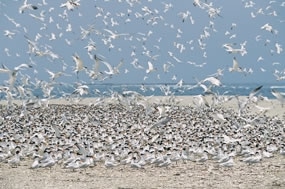
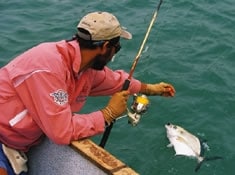
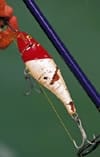
(top) Birds as well as fish abound in this part of coastal Africa. (middle) Pompano offer a light-tackle respite from bouts with gigantic tarpon. (bottom) Plugs take a beating from repeated assaults by a variety of local inshore bruisers.|
Two things make this fishery unique. First, as Africa’s largest archipelago, the Bijagos encompasses 30,000 square kilometers. Of the 78 major islands, only 20 are inhabited, with a total population of less than 5,000. Second, the region is one the largest estuarine environments in Africa, fed by four massive, nutrient-rich river systems. The result is a biological marvel of diversity.
In some places, clear waters teem with clouds of plankton, attracting huge quantities of baitfish and an all-star cast of predators. Other spots feature mazes of mangroves, white-sand beaches, rocky outcroppings and underwater canyons.
“It’s a wonderful place,” Sebile says. “There is so much here and so few people competing for it. I think if you were to travel back in time a million years, you would find this region and this fishery virtually the same.”
Land of the Giants
My April trip to the Bijagos provided just a taste of the area’s potential. On our first day out, we ran home in complete darkness with only a GPS to guide us. Our boat had no running lights and no radio, and our route was illuminated by the gentle glowof Jupiter and a fingernail moon reflecting off the gentle chop of the sea.
We were running late for good reason. Lodge guest Pierre Buattaz had landed his first-ever tarpon, and it had taken him one hour and 40 minutes to land the fish. At 237 pounds, it was slightly larger than average and an impressive introduction to the fishery. Of equal interest was the fact that it was the 36th tarpon of the season landed in excess of 220 pounds.
The week before, six tarpon had been hooked. All were large and all were eventually lost. This one brought a collective sigh of relief. Back at the club we enjoyed a celebratory nightcap as bats flitted through the yellow light of the outdoor dining area. “We could land so many more of these fish,” Sebile told me, “if only more of my clients wanted to fish for them. We are surrounded by giant tarpon here, but most of my guests will only dedicate a day to chasing them. Ultimately, it’s the jacks, barracuda, tiger sharks and giant snapper that keep my guests coming back.”
The fact is that giant tarpon in Guinea-Bissau are a bonus to the already great fishing for other species. Still, there is no denying that until you actually hook one of these beasts, the process is, in my book, rather uneventful.
The standard setup is simple: First, take a stout rod with whatever line class you choose, then attach a big spinning reel with lots of line and a heavy-duty shock tippet that terminates in a giant circle hook. Roughly four feet above the hook, attach a large float. Lastly, run the hook through the nose of a dead, seven-inch mullet that the local tarpon adore.
Big Tides, Big Fish
For newcomers to the area, the hot spots are hard to identify, but rest assured that the guides have them hard-wired into their memory. In the middle of some seemingly featureless water are plateaus and channels that concentrate the tarpon. Typically, the water is less than 15 feet deep, and the current pulls strongly due to tides that average eight feet.
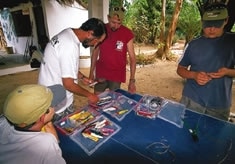
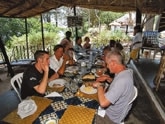
(top) Back at the lodge, tackle boxes are loaded with a selection of swimming and topwater plugs to optimize angling opportunities. (bottom) Fish stories are swapped over delicious meals at the Africa Bijagos Tarpon Club.|
Once the boat is anchored, the baits are set 30 to 50 feet behind the transom and the rods placed in holders. Meanwhile, the anglers sit tight, doing their best to think good thoughts. Only after one of the massive tarpon grabs a bait and jumps does the angler take the rod, set the hook with all his might and hang on for a tug-of-war not soon to be forgotten.
What are the chances of success? For a fish of 150 pounds or less, they are extremely poor. For a fish of between 150 and 190 pounds they are somewhat better. And for a fish of between 190 and 300 pounds they are pretty damn good. As an IGFA official and dedicated tarpon junkie, Sebile’s records show that his anglers average 1.15 hook-ups on giant tarpon per day. Some days there are none and other days there are several, but invariably the fish landed by his clients weigh in at slightly over 200 pounds! Such staggering statistics beg the question as to where the small fish are. To date, no one seems to have an answer.
Beyond Tarpon
Is Guinea-Bissau the world’s ultimate giant-tarpon destination? Without a doubt, the answer is yes. However, there are many more species to fish for besides tarpon in the Archipelago de Bijagos. The incredible number of voracious, plug-slamming jack crevalle, many of which exceed 40 pounds, seem to be the region’s strongest draw, followed by barracuda, one of which exceeded 70 pounds this season. Then there’s the 20 species of shark (five of which commonly exceed 400 pounds), amberjack, Senegalese jack, cobia, drum, bonefish, permit, pompano, grouper, guitarfish, ladyfish, leer fish, sierra, sea bass and tripletail.
While Sebile would likely fish for tarpon most every day, his guiding associate, Guilhem Moutagut, feels that the region’s massive tiger sharks offer the ultimate thrill. Pursued with stand-up tackle from a small boat, these beasts typically run from 400 to 1,200 pounds. A tiger estimated at 2,000 pounds was landed at the club, but did not qualify for an IGFA record as it necessitated a group effort and ultimately bottomed out the 1,500-pound scale.
Camping out on isolated sandspits or uninhabited beaches with a backdrop of jungle hardwoods is another must-do activity. Outfitted with little more than tackle, a sleeping pad, a grill and a cooler of Portuguese beer, anglers can fish late into the night in one of the most primal settings imaginable.
Is this trip for everyone? Is it worth the effort of traveling to a developing country that receives less than 400 tourists annually? If you lust for the taste of a truly wild salt water environment or have a hankering to do combat with a tarpon that might possibly top 300 pounds, nothing could be more perfect.
If You Go to Guinea-Bissau
SEASON: Mid-October through May.
CURRENCY: The economy is based on the CFA Frank, but guests need only Euros. Leave your dollars at home!
ACCOMMODATIONS: The tarpon club has 11 modest rooms with private baths and can accommodate up to 22 anglers.
LANGUAGE: Lodge employees primarily speak French, although several key members of the staff speak excellent English. The majority of Guinea-Bissau speaks Portugese.
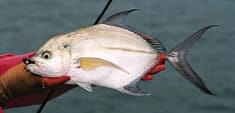
Feisty pompano hit leadheads fished on light spinning tackle.|
POLITICAL STABILITY: Currently, the situation in Guinea-Bissau is stable and improving, but West Africa as a whole inherently lacks long-term stability. On a comforting note, the Bijagos Archipelago is world apart from the capital, and the club and has catered to foreigners continuously, and safely, for the past 15 years.
TRAVEL: From New York, anglers fly to Senegal, check into a day room, then proceed directly to the lodge. In the event of rough seas, the occasional group will have to overnight in Bissau before reaching the islands.
BOOKING: For comprehensive information and detailed itineraries, contact Fly Water Travel, (800) 552-2729, www.flywatertravel.com. or Lure and Feather Co., (631) 329-5829.





